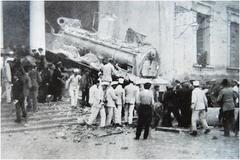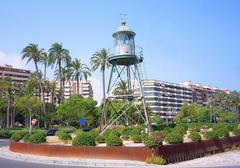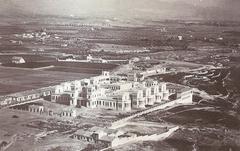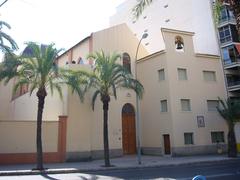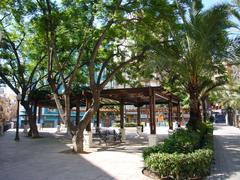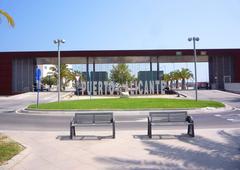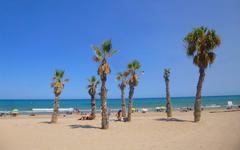
Luceros Alicante, Spain: Visiting Hours, Tickets, and Travel Guide
Date: 03/07/2025
Introduction
Plaza de los Luceros, affectionately known as Luceros, is the beating heart of Alicante—an architectural gem, social hub, and the city’s main transportation nexus. Inaugurated in 1930, Luceros symbolizes Alicante’s transformation from a provincial Mediterranean port to a modern city. At its center stands the iconic Fuente de los Luceros, an Art Deco masterpiece by Daniel Bañuls Martínez, featuring allegorical horses that represent Alicante’s openness to the world. The plaza is a focal point for cultural festivities, daily life, and urban connectivity, making it a must-see for visitors seeking both the city’s history and contemporary vibrancy (alicanteturismo.com, Evendo, alicantelikealocal.com).
This comprehensive guide explores Luceros’ historical significance, architectural features, visitor information—including hours, ticketing, accessibility, and transport options—as well as local tips to enhance your Alicante experience.
Table of Contents
- Introduction
- Historical Origins and Urban Development
- Cultural and Social Significance
- Architectural Features
- Visitor Information
- Frequently Asked Questions (FAQ)
- Enhance Your Visit
- Visuals and Interactive Content
- Conclusion
- References
Historical Origins and Urban Development
Early 20th-Century Expansion
Luceros was conceived during a period of rapid modernization and urban expansion in Alicante. Its circular design, where major avenues such as Avenida de la Estación, Avenida Alfonso X el Sabio, Avenida General Marvá, and Avenida Federico Soto converge, reflects early 20th-century European urbanism. The plaza was officially inaugurated in 1930, with the monumental fountain (Fuente de los Luceros) completed the same year (alicanteturismo.com).
Mid-Century and Modernization
Throughout the 20th century, Luceros evolved as a key urban node. The introduction of the TRAM underground station in the 21st century reinforced its role as Alicante’s main transport hub, seamlessly connecting the city with its neighborhoods and the Costa Blanca.
Preservation and Urban Identity
Restoration initiatives have preserved the plaza’s sculptural and architectural features, ensuring Luceros remains a heritage site protected by local regulations (alicanteturismo.com).
Cultural and Social Significance
Festivities and Celebrations
Luceros is the epicenter of Alicante’s most celebrated events, especially the Hogueras de San Juan in June, where thousands gather for the spectacular mascletàs (daytime pyrotechnic shows) (todoalicante.es). The square’s open design and acoustics amplify these vibrant celebrations.
Community and Urban Life
Beyond festivals, Luceros is a daily meeting point surrounded by cafés, shops, and offices. It is a symbol of Alicante’s civic pride, a place for both spontaneous gatherings and organized events.
Architectural Features
The Fuente de los Luceros fountain is an Art Deco masterpiece, featuring four sculpted horses facing the cardinal points. The fountain is adorned with allegories representing the seasons and natural elements, reflecting both Alicante’s maritime traditions and cosmopolitan outlook. The square itself is framed by elegant early 20th-century buildings with ornate facades and decorative tilework, creating a harmonious urban landscape (alicanteturismo.com).
Visitor Information
Visiting Hours & Tickets
- Plaza de los Luceros: Open 24/7, year-round. Entry is free.
- Fuente de los Luceros: Always accessible as part of the public plaza.
- Shops and Cafés: Operate according to their own business hours.
Guided Tours & Photography
- Guided Tours: Numerous local operators include Luceros in walking tours, sharing historical and artistic insights.
- Photography Tips: Visit at sunrise, sunset, or during evening illumination for optimal photos. The plaza’s symmetry and fountain details offer excellent photo opportunities.
Accessibility
Luceros is fully accessible, featuring ramps, tactile paving, and wide pedestrian paths. The TRAM station below the plaza includes elevators and escalators (alicanteturismo.com).
Transportation
- TRAM: The Luceros station is Alicante’s main tram hub, serving five lines that connect the city center with Benidorm, San Vicente del Raspeig, El Campello, Playa de San Juan, and the maritime front (seat61.com).
- Bus: Multiple city bus lines stop at or near the plaza.
- Train: Alicante’s main railway station is a short walk away.
- Airport: The C6 bus connects Alicante airport with the city center and main stations.
Best Times to Visit
- Festivals: Late June for Hogueras de San Juan offers the most dynamic experience.
- Regular Days: Early mornings and evenings provide a peaceful atmosphere and beautiful lighting.
Nearby Attractions
- Santa Bárbara Castle: A historic fortress with panoramic views.
- Old Town (El Barrio): Charming streets and lively nightlife.
- Explanada de España: Iconic palm-lined promenade.
- Mercado Central: Bustling local market (open Mon-Sat, 07:30–14:30). (planetware.com)
Amenities & Safety
The plaza features public seating, shaded areas, ATMs, and nearby restrooms. Tourist information points and a visible police presence enhance safety, especially during large events.
Frequently Asked Questions (FAQ)
Q: Is there an entrance fee to visit Luceros?
A: No, the plaza and fountain are open to the public, free of charge.
Q: Are there guided tours available?
A: Yes, many local operators include Luceros in their city tours.
Q: How do I get to Luceros by public transport?
A: The Luceros TRAM station lies directly beneath the plaza, with extensive tram and bus connections.
Q: Is Luceros accessible for people with disabilities?
A: Yes, the plaza and TRAM station are fully accessible.
Q: When is the best time to visit?
A: For festivities, visit in late June; otherwise, mornings and evenings are ideal for sightseeing and photography.
Enhance Your Visit
- Download the Audiala App for personalized travel tips, guided tours, real-time ticketing, and event updates.
- Join a Guided Tour to gain deeper insights into Luceros’ history and local culture.
- Capture the Moment: Bring your camera for photos of the fountain, illuminated evenings, and lively events.
- Explore Local Cuisine: Enjoy coffee or tapas at cafés around the plaza.
Visuals and Interactive Content
For an immersive experience, consult online galleries and interactive maps on official tourism websites. Look for optimized images with alt text such as “Fuente de los Luceros fountain at night,” “Luceros TRAM station entrance,” and “Hogueras de San Juan festival at Luceros.”
Conclusion
Plaza de los Luceros is more than a landmark—it’s the living, breathing core of Alicante. From its Art Deco fountain and elegant architecture to its role as the city’s festival epicenter and transport hub, Luceros offers visitors an authentic window into Alicante’s past, present, and future. Whether you’re exploring history, enjoying local events, or connecting to the wider Costa Blanca, Luceros promises a memorable and accessible experience for all.
Plan your visit today—download the Audiala app, explore our related guides, and follow us on social media for the latest updates and inspiration. Experience the vibrant soul of Alicante at Plaza de los Luceros.
References
- Visit Plaza de los Luceros in Alicante: History, Tips, and Must-Know Info (alicanteturismo.com)
- Cultural and Social Significance of Luceros (Evendo)
- Luceros Alicante: Visiting Hours, Tickets, and Guide to Transport and Attractions (alicantelikealocal.com)

